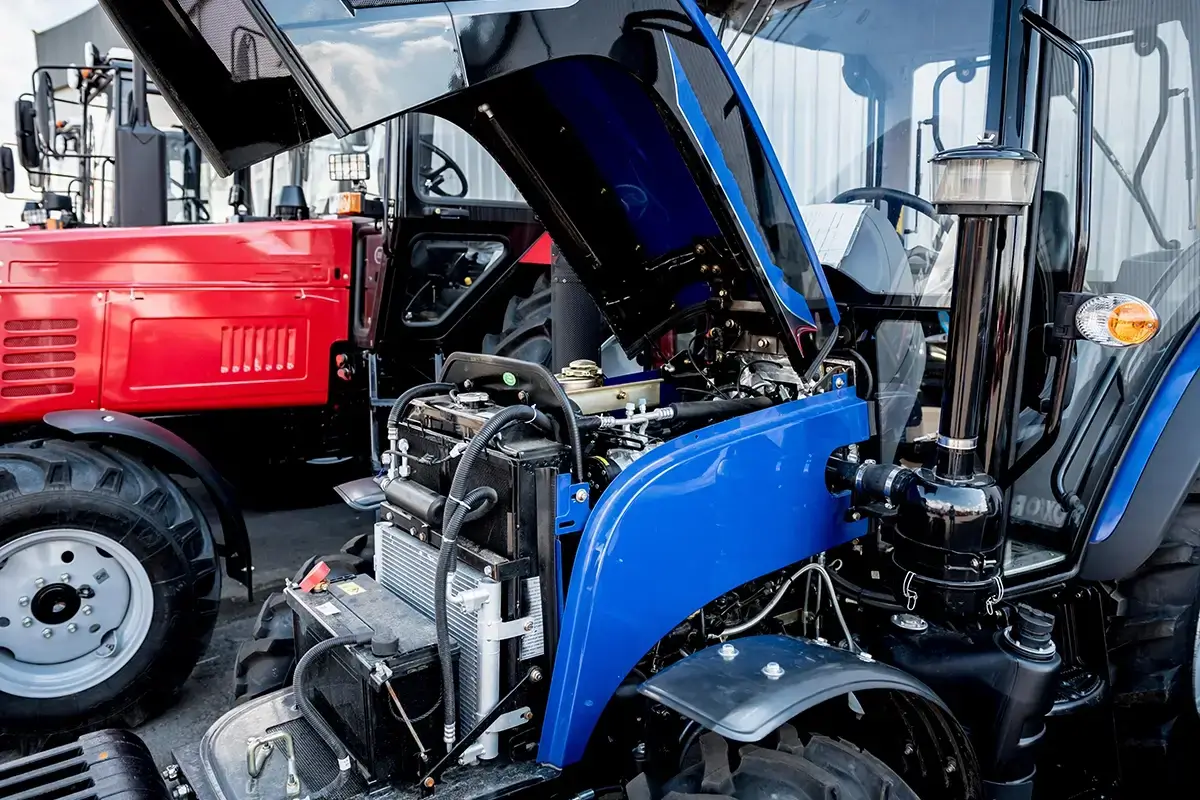How to get a longer working life out of your tractor
25 Apr 2023

Tractors are the backbone of global agriculture. From South American citrus fruit and Asian soybean farms, to wheat fields in Central Europe – tractors enable us to feed almost eight billion people on our planet. But, what ensures a long and reliable life from your tractor? Tractors are a major cost and investment for any farmer, particularly small holdings and farming collectives. Proper maintenance and care are essential for longevity. As a machine with many moving parts, lubrication is perhaps the single most important factor to maintaining reliability from a tractor.
Which parts of a tractor need lubricating?
Moving mechanical parts generate friction. Agricultural oil, grease and other lubricants help reduce this friction - and the harmful heat and wear it causes. Diesel, petrol (gasoline) and hybrid tractors, and other self-propelled farm machinery, contain many metal-on-metal moving parts such as bearings, joints and oscillating points. They also work in a dusty, dirty and often wet environment, where soil, sand and grit can threaten to get into moving parts and damage them. The right engine oil and lubricants help prevent premature wear, corrosion and failure.
Powered by a diesel or petrol (gasoline) motor, the highest number of vulnerable moving parts on a tractor are within the engine and transmission (gearbox). These are predominantly lubricated and protected by the engine oil. However, there are also many other areas of a tractor’s chassis – including the wheels, axles, steering, hydraulics and power take-off (PTO) which require lubrication too. So, let’s take a look at each area and how you can use lubrication to ensure a longer life from your tractor or agricultural vehicle:
How does oil protect a tractor’s engine?
Most tractors and self-propelled agricultural machinery have a diesel or petrol (gasoline) fuelled engine. This provides power to move the tractor, pull equipment including trailers or plows (ploughs) and provide auxiliary power via the PTO to machinery such as an auger or baler. Like any other diesel or petrol (gasoline) combustion engine, a tractor’s motor requires continual internal lubrication which it receives from engine oil.
The engine oil in a tractor performs a number of functions:
• Reduces the friction between moving parts – particularly the pistons and the cylinder walls
• Reduces the power required by moving parts to overcome friction – providing more available power for motion
• Reduces the wear of moving engine components – lengthening the engine’s life
• Reduces the heat generated due to friction - and helps dissipate heat via the oil cooler
• Cleans engine components by helping remove metallic fragments, dust and other harmful deposits

How often should you lubricate your agricultural machinery?
The frequency with which you change the motor oil in your particular tractor is typically defined by the manufacturer in working hours. You can choose to change your engine lubrication more frequently - but you should never leave it longer than the manufacturer recommends.
For a modern medium-duty tractor, many manufacturers recommend engine oil changes every 100 or 200 hours of use. The manufacturer will also specify the grade (viscosity or thickness) of the motor oil which should be used. A tractors transmission or gearbox typically has its own lubrication or fluid which should be changed at similar intervals.
Each tractor manufacturer will recommend the grade and brand of fluids to be used in their vehicles. This can typically be found in the user manual, service manual or by contacting a main dealer. For example, Gulf Superfleet Supreme is a heavy-duty engine oil which provides excellent protection to keep diesel tractor and agricultural vehicle engines running smoothly. It helps minimise soot build-up to ensure the engine runs cleaner for longer to minimise downtime.
Lubricating other parts
There are many other areas of a tractor or agricultural vehicle which require regular lubrication or fluid changes. Comprehensive details can usually be found in the service manual for the specific vehicle. Common areas which require oil or lubricant changes include the front differential, wheel case and rear axle. Other regular fluid changes include engine coolant, power steering fluid, hydraulic fluid and brake fluid. For example, Gulf Syngear is an advanced fully-synthetic agricultural gear oil for use in the transmissions, final drives and axles of tractors and agricultural vehicles being used in the most severe operating conditions.
There are also many components of a tractor which require regular greasing, including:
• Ball joints
• Bearings
• Steering cylinder ball joints
• Steering components
• Hitch pivot points
Grease is a heavy form of lubricant which is manufactured from oil, with additives to make it thick and clingy. A range of greases are available. It is important to consider what you need it to lubricate and the conditions it will encounter, including temperature and moisture levels. Most manufacturers recommend a high-quality lithium grease as it reacts less with air and contains detergents which prevent contaminates from slowing performance. For example, Gulf Crown MP a multi-purpose lithium grease manufactured from highly refined mineral oil and formulated with performance enhancing additives for excellent protection against wear and corrosion.

Making it easy for farmers
With so many moving parts you could end up spending a small fortune on various products. In order to reduce costs and make it easier to maintain your farming equipment Gulf created Super Tractor Oil Universal (STOU) which is a class of multipurpose tractor and agricultural vehicle oil which meets major manufacturers requirements for various mechanical components, including engine, gears, transmission, hydraulics and brakes. Utilising a single fluid for all these applications helps avoid the risk of using the wrong fluid.
Gulf’s Super Tractor Oil Universal range is designed for use in both the engine and hydraulic brake systems of agricultural vehicles. It can be used in either diesel or petrol (gasoline) engines, as well as in conventional gear drives, powershift transmissions, hydrostatic transmissions, hydraulics, final drives, power steering systems and oil-immersed brakes. As a lubricant, it reduces wear and protects gears, transmissions and bearings from wear, scuffing and pitting. As a fluid, it ensures the smooth operation of hydraulics and brakes, including better performance from cold starts.
Oils and lubricants make the difference for tractors
The life of a tractor or agricultural vehicle is rarely an easy one – working hard on rough terrain, in all weathers.
With so many moving parts, lubrication is vital for protection, reliability and maintaining power. Regular servicing and maintenance with high-quality oils, lubricants and fluids can significantly prolong your tractor’s working life.
Discover our range of agricultural lubricants.

